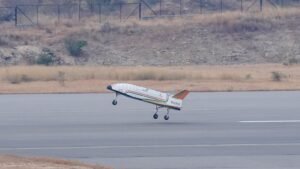
Why in news?
- In a significant stride towards advancing space exploration, the Indian Space Research Organisation (ISRO) has recently achieved a notable milestone with the successful testing of the Pushpak Reusable Landing Vehicle (RLV) LEX 02 in Chitradurga, Karnataka.
- This groundbreaking experiment marks a pivotal moment in India’s space endeavors and holds promising implications for the future of space missions.
Overview of the Reusable Landing Vehicle (RLV) LEX 02:
- The RLV-LEX 02 experiment represents the second phase in a sequence of tests following RLV-LEX 01.
- The primary objective of this mission was to demonstrate the autonomous landing capability of the RLV, affectionately named Pushpak.
- This innovative vehicle is designed to facilitate repeated launches and landings, thereby significantly reducing the costs associated with space exploration.
Methodology of the Experiment:
- The experiment employed a series of sophisticated techniques to test the capabilities of the RLV LEX 02:
- Challenging Autonomous Landing:
- The RLV LEX-02 mission showcased Pushpak’s ability to autonomously land under challenging conditions.
- It was released from a Chinook helicopter at an altitude of 4.5 kilometers, demonstrating its capability to navigate and land accurately.
- Automatic Control Adjustments:
- Pushpak approached the runway autonomously, making real-time adjustments as necessary to ensure a precise landing.
- It utilized a combination of brake parachutes, landing gear brakes, and a nose wheel steering system to execute a controlled descent and touchdown.
- System Reuse from RLV-LEX-01:
- In a testament to efficiency and resource optimization, all flight systems from the previous RLV-LEX-01 mission were repurposed for RLV-LEX 02 after undergoing necessary certifications.
- This approach underscores ISRO’s commitment to sustainability and cost-effectiveness in space exploration.
- Collaboration of Agencies:
- The mission’s success was made possible through the collaborative efforts of several key agencies, including the Vikram Sarabhai Space Centre (VSSC), Liquid Propulsion System Centre (LPSC), and ISRO Inertial Systems Unit (IISU). Their collective expertise and dedication played a vital role in achieving this milestone.
- Challenging Autonomous Landing:
Implications and Future Prospects:
- The successful testing of the Pushpak RLV LEX 02 holds immense significance for India’s space program and the global aerospace community. Some notable implications include:
- Cost Reduction: By developing reusable launch vehicles like Pushpak, ISRO aims to significantly reduce the cost of space missions, making them more accessible and sustainable in the long run.
- Technological Advancement: The autonomous landing capability demonstrated by Pushpak represents a significant technological feat, paving the way for more sophisticated space exploration missions in the future.
- Commercial Opportunities: The development of reusable launch vehicles opens up new opportunities for commercial space ventures, including satellite launches, space tourism, and scientific research.
- International Collaboration: ISRO’s achievements in space exploration continue to garner international attention, fostering collaboration and knowledge-sharing among global space agencies.
Conclusion
- The successful testing of the Pushpak RLV LEX 02 represents a remarkable achievement for ISRO and a significant milestone in India’s journey towards becoming a leader in space exploration.
- As the capabilities of reusable launch vehicles continue to evolve, the possibilities for scientific discovery and technological innovation in space exploration are boundless.
People also ask
Q1: What is the Pushpak Reusable Landing Vehicle (RLV) LEX 02 experiment?
Ans: The RLV-LEX 02 experiment is a test conducted by the Indian Space Research Organisation (ISRO) to demonstrate the autonomous landing capability of the Pushpak Reusable Landing Vehicle.
Q2: Where was the Pushpak Reusable Landing Vehicle LEX 02 experiment conducted?
Ans: The experiment took place in Chitradurga, Karnataka, India.
Q3: What is the purpose of the Reusable Landing Vehicle-LEX 02 experiment?
Ans: The primary objective of the experiment was to showcase Pushpak’s ability to autonomously land under challenging conditions, thereby advancing India’s capabilities in space exploration.
Q4: What method was used for the Reusable Landing Vehicle-LEX 02 experiment?
Ans: The experiment involved releasing Pushpak from a Chinook helicopter at an altitude of 4.5 kilometers. Pushpak then autonomously approached the runway, making real-time adjustments as necessary, and executed a controlled landing using brake parachutes, landing gear brakes, and a nose wheel steering system.
Your article helped me a lot, is there any more related content? Thanks!